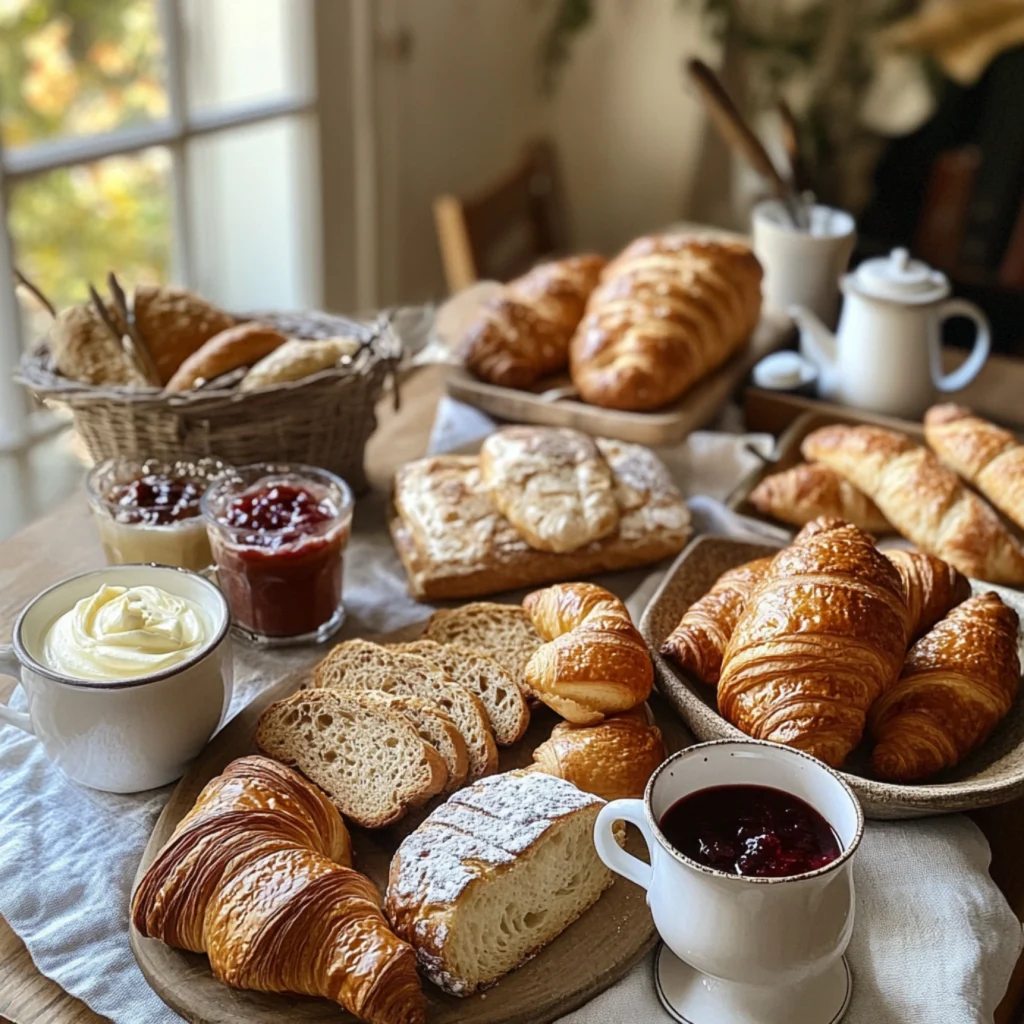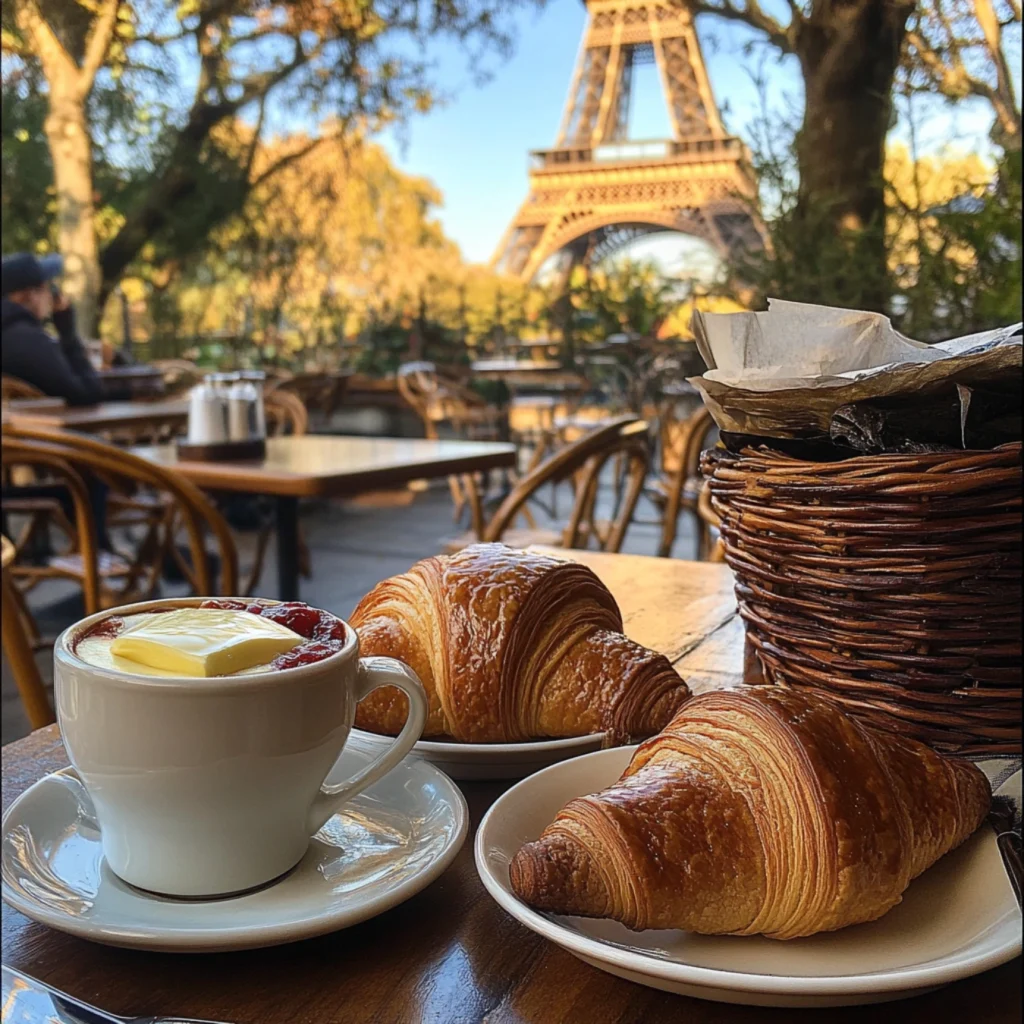The way the French eat breakfast is effortlessly fashionable. French breakfast foods embrace simplicity, elegance, and appropriate indulgence, unlike the heavy, savory morning meals in other countries. Sounds wonderful, right? Think delicious croissants, crusty baguettes slashed with butter and jam, and a cup of café au lait.
But there’s more to French breakfasts than meets the eye. From the traditional tartines of Paris to the crêpes of Brittany, every area puts their spin on the morning meal. And while the French may not be huge on eggs and bacon in the morning, they surely know how to convert a modest meal into a moment of pure delight.
In this tutorial, we’ll dive deeply into traditional French morning foods, find their origins and variants, and learn how you may recreate them at home. So, take your favorite coffee and explore the delicious world of French breakfasts!
Table of Contents
French Breakfast Foods: An Overview
Why French Breakfast Is Unique
Breakfast in France isn’t about speed or stuffing yourself full. It’s about savoring a little but good beginning to the day. Unlike the hearty, protein-packed breakfasts of the U.S. or the UK, the French prefer something light, buttery, and perfectly paired with coffee. A traditional breakfast consists of bread, pastries, or a basic dairy product like yogurt, sometimes accompanied by fresh fruit or juice.
One element that sets French breakfast apart is its emphasis on quality. Instead of processed cereals or quick coffee, the French choose freshly baked products and rich, aromatic coffee. Each bite and sip is meant to be savored—no rushing allowed!
The Simplicity of a Traditional French Breakfast
While lunch and dinner in France can be expensive, breakfast remains surprisingly modest. Most homes start the day with a warm drink usually coffee, tea, chocolate chaud, or hot chocolate. This is generally paired with:
- A baguette or tartines: Thin slices of crusty French bread, often spread with butter, jam, or honey.
- Common favorites: Pastries, brioche, pain au chocolat, and croissants.
- Fruit and yogurt: A better, lighter, more healthful substitute.
- Juice or milk: Freshly squeezed orange juice is a popular choice.
French Breakfast: Unlike Other Cultures
Unlike American breakfasts, which might call for eggs, bacon, pancakes, and hash browns, the French keep their mornings straightforward and sweet rather than savory.
- No heavy proteins: The French rarely eat eggs, sausage, or bacon in the morning.
- Grab-and-go style: Breakfast is often a grab-and-go event requiring minimal cooking preparation.
- Beverage first: There is more coffee and less food; the morning beverage takes the front stage rather than the meal.
While it may seem light to some, the French breakfast perfectly balances indulgence and simplicity, setting the stage for a leisurely and refined start to the day.
Classic French Breakfast Foods: Components
Baguette and Tartines: The Everyday Staple
A fresh, toasty baguette is the core of a typical French breakfast. Sliced into thin pieces and toasted lightly, it becomes a tartine, often topped with butter and jam. The key to a great tartine is high-quality ingredients—real butter, homemade preserves, and a perfectly crisp baguette.
For a flawless French tartine, follow these guidelines:
- Ingredient Description:
- Fresh, crusty French bread in bags.
- Butter: Unsalted, high-quality European butter.
- Jam or Honey: Jam of apricot, strawberry, or fig; fragrant honey.
- Optional Extensions: Nutella, almond butter, or soft cheese.
🥐 Want a creative twist? Try croissant toast for a unique French breakfast treat!
Croissants and Pastries: Indulgence for Mornings
The French love their pastries; nothing says French breakfast quite like a croissant. Flaky, buttery, and golden brown, it’s best enjoyed fresh from the bakery. Other beloved possibilities include:
- A croissant loaded with creamy, melted chocolate is pain au chocolat.
- A spiral pastry packed with custard and raisins is pain aux raisins.
- Brioche – A sweet, buttery bread, often covered with sugar.
🥜 Looking for a unique take on croissants? Check out pistachio croissants for a gourmet twist!
Coffee and Hot Chocolate: The Essential Beverages
Without a hot drink, no French breakfast would be whole. Coffee is king, but tea and chocolate chaud (hot chocolate) are common. The French typically enjoy:
- Café au lait: Large bowl presentation of hot milk coffee.
- Espresso: A powerful shot of coffee for a quick caffeine boost.
- Hot Chocolate: Made often with melted chocolate, thick, rich hot chocolate is known as chocolat chaud.
Fruit, Yogurt, and Fresh Juice: A Healthier Take
The French go to fresh fruit and dairy for a smaller breakfast. Sometimes plain or mildly sweet, yogurt pairs nicely with a handful of berries or a drizzle of honey. Popular drink choice: fresh squeezed orange juice provides a cool counterpoint to rich pastry.
Whether your taste is for a basic tartine or a rich, flaky croissant, French breakfast cuisine is mostly about appreciating the experience. Bread, pastries, and coffee make up a classic French breakfast.
🍏 Love fruit-based breakfasts? For even more inspiration, try these apple breakfast ideas!
French Breakfast Foods: Regional Variations
Breakfast Parisian: Elegance and Café Culture
In Paris, breakfast is generally a social occasion. At their preferred café terrace, locals nibble on a basic croissant or tartine and sip café crème. Breakfast typical of Parisians consists of:
- Tartines stuffed with jam and butter.
- Café lait, sometimes known as espresso.
- Freshly squeezed fruit juice.
- Sometimes, a soft-boiled egg (oeuf à la coque) accompanied by bread soldiers.
Mediterranean Influence Using Fresh Fruits in Southern France
Breakfast has a Mediterranean touch in locations like Provence and the Côte d’Azur. With a warm environment, lighter, fruit-based breakfasts are preferred:
- Grapes, apricots, and fresh figs.
- Pastries based on almonds or hazelnuts.
- Olive bread (fougasse) with honey.
- Herbal teas or café noir.
Alsace and Lorraine: German-Inspired Breakfasts
Breakfast tables in Northeastern France show German influence. Rich and hearty, it sometimes comprises:
- Kugelhopf – A yeasted cake containing raisins and almonds.
- Pretzels topped with cheese and butter.
- Smoked meats and cheeses.
- Good black tea or coffee.
Brittany: The Galette and Crêpes Home
Brittany is famed for its crêpes and galettes. Galettes are savory using buckwheat flour, while crêpes are sweet and produced with wheat flour. In Brittany, a normal breakfast consists of:
- Crêpes with butter, sugar, or fruit jam.
- Galettes loaded with eggs, cheese, or ham.
- Apple cider or a dish of heated milk.
🥐 For bite-sized indulgence, consider mini croissants perfect for a petite French breakfast!

French Breakfast Ideas to Try Right Here at Home
Bringing French morning foods into your home is easier than you would think! You can make a wonderful French-style breakfast at home with just a few premium products and basic cooking methods. Let’s investigate some recipes you really should try.
Making a Perfect French Baguette: Techniques
An early morning fresh, crusty baguette is the best. While it takes patience, the result is well worth it. Here’s a simple recipe to get started:
Ingredients include:
- 500g bread flour
- 10g salt
- 7g dry yeast
- 350ml warm water
Guideline:
Mix flour, yeast, and salt in a bowl. Add warm water gradually; knead until a smooth dough results. Let it rise for 2 hours, then shape into baguettes. Bake till golden brown, 20 minutes at 220°C (430°F).
For the best French breakfast, team it with butter and jam!
Basic French Croissant Recipe
If you adore croissants, why not bake them yourself? The outcome is a bakery-worthy delicacy, even if it takes time!
Products:
- 500g general all-purpose flour
- 10 grams of salt
- 50g sugar
- 10g rapid yeast
- 300ml warmed milk
- 250g chilly butter (for laminating)
Instructions:
Mix flour, salt, sugar, yeast, and milk. Knead into a smooth dough and let it rest. Roll out the dough and laminate it several times using cool butter. Cut into triangles and roll into croissant shapes. Proof for two hours; then bake for twenty minutes at 190°C (375°F).
Made-from-scratch Sweet and Savory Crêpes with Fillings
Crêpes are a classic breakfast staple, perfect with a variety of toppings!
Simple Crêpe Batter:
- 250g flour
- 500ml milk
- Third egg
- 30g melted butter
Whisk ingredients together; cook in a buttered pan; present alongside jam, honey, or Nutella.
The French Café Experience
Sipping a morning coffee at a French café is a traditional Parisian experience. Whether you’re in France or recreating the ambiance at home, here’s how to enjoy the French breakfast culture like a local.
Expect from a French Café at Breakfast Time
Unlike in the U.S., where breakfast is a full meal, the French prefer something light. Usually, in a café, you will find:
- Tartines with butter and jam
- Croissants or pain au chocolat
- Café lait, sometimes known as espresso
French breakfasts are quick, basic, and always accompanied with coffee; you should not expect complex egg dishes.
Popular Breakfast Orders Found at Parisian Cafés
Knowing what to order is essential if you ever visit Paris! Breakfast combinations most often used consist of:
- Le Petit Déjeuner: A breakfast with a croissant, tartine, orange juice, and coffee.
- A creamy coffee accompanied with a fresh croissant is café crème & croissant.
- Pain Perdu: The French variation of French toast presented alongside fruit or syrup.
For an authentic café experience at home, try this croissant toast recipe for a delicious twist on a classic.
How to Order Breakfast Like a Local
To fully embrace French breakfast foods, follow these simple tips:
- Avoid takeaway – The French love their mornings at a leisurely pace.
- Stay with coffee and pastries; pancakes or scrambled eggs are absent here!
- Say “Un café, s’il vous plaît”—a basic espresso is always a wise decision.
A classic French café breakfast featuring croissants and café au lait.
The Nutritional Elements of a French Breakfast
Is a French Breakfast Healthy?
While French breakfast meals generally feature buttery pastries and sugary delights, they can still fit into a balanced diet in moderation. The French emphasize fresh foods and portion control, prioritizing quality above volume.
Healthier French Breakfast Choices
To make a French breakfast healthier, opt for:
- Whole-grain bread replaces white baguettes.
- Plain yogurt with fresh fruit instead of sugary cereals.
- Smaller servings of pastries with additions of proteins like cheese or nuts.
Accepting the French approach of conscious eating will help you to enjoy breakfast guilt-free!

Questions on French Breakfast Foods
1. Generally speaking, what is a French breakfast?
A typical French breakfast comprises a hot drink (coffee or tea), tartines (bread with butter and jam), and sometimes a pastry like a croissant.
2. What are common French breakfast foods?
Popular selections include baguettes, croissants, pain au chocolat, crêpes, yogurt with fruit, and fresh juice.
3. Breakfast meals for Parisians?
Parisians often get a quick café crème with a croissant at a local café or have a tartine with butter and jam at home.
4. What are three traditional French morning dishes?
- Tartine with jam
- Sweet or savory content in crêpes
- Brioche with coffee
Simple but sophisticated French breakfasts make mornings wonderful!
Conclusion
French morning foods epitomize the ideal mix of simplicity, excellence, and decadence. Unlike other countries’ substantial, protein-packed breakfasts, the French appreciate light but filling morning meals. Whether it’s a flaky croissant, a crispy tartine with butter and jam, or a cozy café au lait, fresh food and conscious eating always take the front stage.
From the bustling cafés of Paris to the crêperies of Brittany, every region brings its unique touch to breakfast traditions. Though the traditional French breakfast tastes sweet, little tweaks like adding yogurt, fresh fruit, or whole-grain bread can help to balance it even more.
Ultimately, the beauty of a French breakfast lies not just in the food but in the experience. It’s about slowing down, savoring each bite, and starting the day with indulgence.
Bon appetit! ☕

